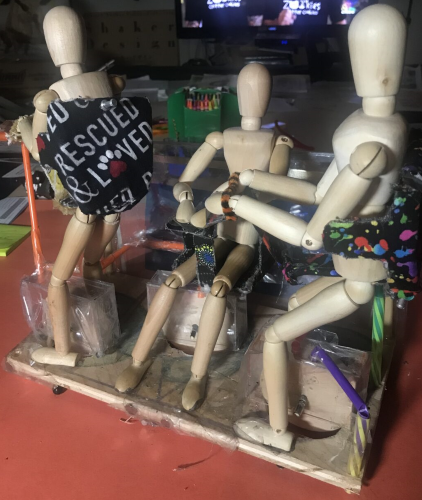How are these vehicles different from current transport and why does that matter?
Each suggests a different approach to designing and deploying our lightest and most accommodating, slow-speed, urban vehicles.
Each provides for the users to determine how much of a cover is being provided for an otherwise almost completely open platform, depending on weather conditions and other factors such as the desire for quiet or privacy.
One has a capacity of up to nine people, the Other only three, and maybe personal, passenger, cargo, or multi-modal. The Half provides for wheelchairs and hand trucks. A version of the Other Half could also.
Most users will be provided with resting places that permit them to choose their posture, recumbent, sitting, leaning, or standing.
Foot and arm cranks will enable energy to be generated, and channeled, into the electrical system, to be used when needed.
They use the least material to accomplish several important tasks, durably, beautifully, economically, sustainedly, and creatively.
One element of this effort is to design for, and have a strong effect upon, over time, the way in which these devices are deployed and the conditions under which they are provided to their operators.
Financing these vehicles, in a manner that enables the eventual ownership of them to be provided to users, is a common feature of the Halves.
Their uniqueness can give local identity to these conveyances and, over time, making them unique through their design and decoration, can emphasize local history and the identity of current residents, can transform these objects into a new medium of expression, education, and needed direct communication.
All local economies can benefit from having a live local employment exchange, a listing of local spaces to be rented, or even sold, offers to donate things that are being discarded, music being played, public and private services available within the vicinity, etc. which also incorporates a digital element.
Since there are three 1/3 day shifts available for the Half, it is likely that there will be groups of two, three, or more different individuals attending to one route. A mechanism for resolving disputes and a system for ensuring equitable activity will be developed. Means of enabling this arrangement could help foster similar, small group, local, beneficial, efforts.
The Other Half is a personal/3-person/pedal cab/cargo vehicle, which also has the ability to move forward in both its 3’ and 6’ directions so that it is possible to sit abreast instead of behind one another, somewhat more “sociable”.
While using advertising and commercial sponsorship as one means of gaining income from the operation of these vehicles, it is expected that these sources of income would be derived from local businesses and professionals.
These machines conform to current NYS and NYC legal regulations regarding these forms of transportation, are and perfect solutions to urban congestion, yet there is nothing resembling them on the roads at the present time.
Tip-only, free transportation along the regular route could be economically feasible if the income generated by other means is sufficient. Tours, place to place travel, and other higher income-producing activities can be blended in.
Contact Steven Stollman: Email | Tel. 212 431 0600

